
Using the admicellar
process and monodisperse spheres organized in an hexagonally packed
structure on a flat surface (see Figure below and Reference 1), |
 |
| Figure 1: Hexagonally
packed latex spheres on graphite |
| We have
synthesized polymer in the interstitial sites of the spheres (see Figure
2). Note the differences in scale between Figures 1 and 2; the polymer
in Figure 2 has characteristic dimensions on the order of tens of nanometers.
The purpose of surfactant is to localize monomer on the surface; the template
(i.e. the spheres) mean that surfactant can only adsorb in the interstitial
sites. There are other ways to localize monomer to the interstitial sites
of spheres (e.g. electrical potential), the interesting thing about this
method is that the polymer is much smaller than the interstitial sites,
i.e. surfactant does not adsorb very far underneath the spheres. The wall
thickness is less than half what you would find for the case where an
electric field is used to concentrate monomer in the interstitial sites.
Figure 3 shows a schematic of the process. Reference 2 below describes
our data, and also contrasts the result for the case where polymer adsorbs
in the interstitial sites. |
 |
|
Figure 2: Polyaniline
synthesized in the interstitial sites of adsorbed latex spheres using the admicellar process. |

References
M. Marquez and B.P. Grady, “The Use of Surface Tension to Predict the Formation of 2D Arrays of Latex Spheres formed via the Langmuir-Blodgett Technique”, Langmuir, 20, 10998 (2004).
M. Marquez, K. Patel, A.D.W. Carswell, D.W. Schmidtke and B.P. Grady, “Fabrication of Nanometer-Scale Polymeric Structures on Surfaces: Pillars and Honeycombs”, Langmuir, 22, 8011 (2006).
M. Marquez, S. Kim, J. Jung, N. Truong, D. Teeters, B.P. Grady, “Factors Affecting the Synthesis of Polymeric Nanostructures from Template Assisted Admicellar Polymerization” Langmuir, 23, 10008 (2007).
M. Marquez and B.P. Grady, “Patterned Nanostructures from Particle Lithography”, Encyclopedia of Nanoscience and Nanotechnology, (Stevenson Ranch, CA: American Scientific Publishers) 2010